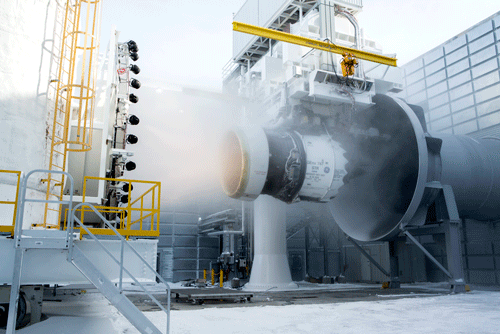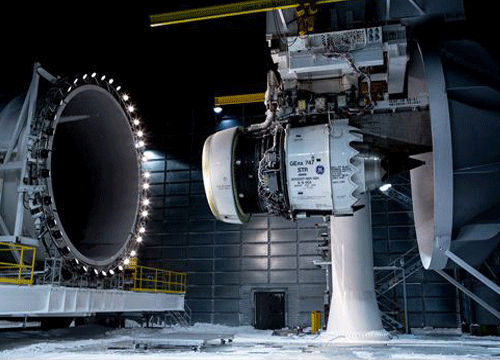Tom Brisken smiles when he sees his jet engine roar down the runway, but it is the smile of a long-distance runner at the end of a marathon. Brisken spent the last decade developing GE’s most advanced large jet engine, the GEnx, as the general manager in charge of large aircraft customer strategies at GE Aviation, and the path to technological breakthrough wasn’t always clear. “There for a while we were biting our nails,” he says.
Today, ten years after the launch of the GEnx program, the engine has beaten expectations and set new records. New data from customers, for example, made Boeing improve fuel burn estimates for the GEnx-2B, which powers the 747-8 cargo planes, potentially saving airlines millions. For Brisken, who retired last year, that’s “like heaven.”

No Pain, No Gain: This GEnx engine must prove its mettle in sub-zero temperatures at GE’s testing facility outside Winnipeg, Canada.
The program gained momentum in April 2004 when Boeing selected the GEnx engine for the 787 Dreamliner. It was an exciting moment, but it sent expectations sky high. Eager to save weight and improve efficiency, GE engineers took the existing state-of-the-art engine, the record-setting GE90, and put it on a crash diet. They eagerly jettisoned composite fan blades and airfoils – so many, that the engine’s performance suffered. “We just went too far,” Brisken says of the strategy. The team had to add some weight back to meet the targets.
Engineers then had to remodel the engine’s lean combustion system to smooth out pressure flows. “It was like going from a four-speed transmission to a continuous transmission,” Brisken says. The hard work shows in the performance data: The GEnx is up to 15 percent more efficient than comparable GE engines. It also generates fewer carbon dioxide emissions.
The engine has already entered the record books. In 2011, a GEnx-1B-powered Dreamliner flew halfway around the world on a tank of gas, then finished the job on the next tank. The journey set a weight-class distance record for the 10,337-nautical mile first leg and a record for quickest around the world flight, an astonishing 42 hours and 27 minutes.
Both the larger GEnx-1B and the slightly smaller 2B engine, which powers the 747-8, are also whisper quiet. Concerned residents reportedly called the San Bernadino Port Authority to complain that Boeing was flying the new 747-8 freighter over their homes with the engines off. They could be forgiven. Pilots have been known to glance at their fuel gauges to make sure the engines are still running.
What’s next? GE engineers are already thinking about using revolutionary new materials called ceramic matrix composites, or CMCs, inside the engines. CMCs can handle temperatures as high as 2,400 degrees Fahrenheit and the punishing forces inside the engines. They are also a third lighter than conventional alloys now used to make jet engine parts.
Say Brisken: “We drain the lake on every piece of technology we have and use it to our advantage.”





